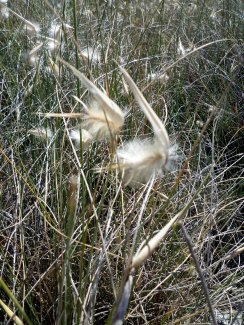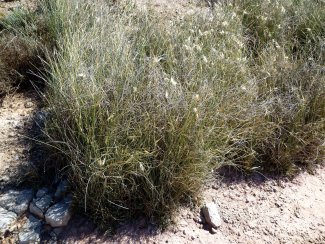Northern Africa: Algeria; Egypt; Libya; Morocco; Tunisia
Western Asia: Egypt - Sinai
Southeastern Europe: Greece - Crete; Italy
Southwestern Europe: Spain
Lygeum spartum (False Esparto Grass) - A spreading rhizomatous grass with vertically-inclined pale yellowish gray-green rush-like leaves that grow to 2-3 feet tall. In spring into summer appear the curious flowers of this grass which have 2 or 3 large single flower spikelets fused together at the base surrounded by many long hairs and are further enveloped by a pair of large pale-colored spathe-like bracts. This plant is naturally widespread throughout the Mediterranean from southern Italy and Crete west to the Iberian Pennisula and in North Africa where it is found on clay and chalky soils in arid climates from 400 to 3,200 feet in elevation, often higher than the similar more coastal Stipa tenacissima. Both are very tolerant of saline soils. This grass has been commonly called Esparto Grass but this name is more correctly used for Stipa tenacissima while the common names for Lygeum spartum are Albardín, Alvarde or False Esparto.
Lygeum spartum is used for its leaf fibres. It is commonly marketed, like the commercially more important Stipa tenacissima L.,under the name of ESPARTO GRASS. Both species have similar narrowleaves and are difficult to distinguish, except at flowering timewhen the former cannot be confused with any other grass, as already mentioned above. Esparto is a major economic resource in the arid zones of Morocco, Algeria and Tunisia, and was formerly also important in Spain. Although a wild resource, grassland has traditionally been managed so as to protect esparto from excessive harvesting or grazing, although over-grazing has become a severe problem in the late twentieth century. Most local use is for cordage, either as dry leaves, or as fibres after wetting in sea water. Uses include making sandals, ropes,brushes, matting, mattress-stuffing and, in Italy, covers for winebottles. The use of esparto fibres for paper-making is comparatively recent and originated in the British Isles.

